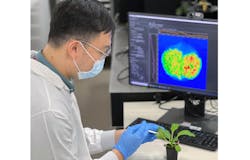Nanosensor breakthrough enhances agricultural science
Singapore-MIT Alliance for Research and Technology (SMART) researchers and colleagues from the Disruptive and Sustainable Technologies for Agricultural Precision (DiSTAP) and the Temasek Life Sciences Laboratory created near-infrared (near-IR) fluorescent carbon nanotube sensors to detect gibberellins (GAs), a class of plant hormones that are crucial for growth (see video).
The nanosensor differentiates between GAs and two other related hormones: GA3 and GA4—diterpenoid phytohormones, which help control the processes involved in plant growth and development.
“We now have a tool to monitor, in real time, how our crops are growing—allowing us to make expedient adjustments or interventions when necessary,” says Mervin Chun-Yi Ang, associate scientific director of DiSTAP, an interdisciplinary group that’s part of the SMART alliance.
The sensors are polymer-wrapped, single-walled carbon nanotubes (SWNTs) featuring corona phases that selectively bind to bioactive forms of GA, GA3, and GA4. This triggers near-IR fluorescence intensity changes, which are then measured to detect and quantify GA levels in living plants.
The work is an extension of the team’s previous research involving SWNT nanosensors using a corona phase molecular recognition (CoPhMoRe) platform, a concept originally introduced by MIT Professor Michael Strano’s lab. With their new CoPhMoRe technique, the researchers can create nanoparticles that act like natural antibodies—they can recognize and lock onto specific molecules.
After first developing CoPhMoRe nanosensors for detecting hydrogen peroxide, synthetic auxin, nitroaromatic, and arsenic, the team’s CoPhMoRe library screening has shown these nanoparticles are highly selective and bind specifically to GA3 and GA4, causing significant fluorescence intensity changes. On the other hand, Ang notes, these nanosensors report negligible fluorescence changes when mixed with other GAs as well as other plant hormones.
Distinguishing different GAs is exceedingly challenging due to their chemical structure similarities.
“Our versatile nanosensing approach can be easily applied for in vivo, real-time detection of different GAs across a broad range of plant species,” says Gajendra Pratap Singh, senior scientific director of DiSTAP. “They are also able to provide spatial and temporal information that was previously inaccessible.”
The nanosensor has shown elevated levels of GA at the lateral root bud of plants and at the junction between the primary root and lateral root bud, indicating that lateral root emergence requires GA signaling. In contrast, current methods for GA detection and quantification involve destructive collection processes followed by liquid chromatography or immunoassays, which are time- and labor-intensive. These analytical techniques can also only measure average concentrations of GA in the plant samples with no spatial information available.
Supplementing technologies
The newly developed optical system—a coupled Raman/near-IR fluorimeter—will assist in the research by enabling self-referencing of SWNT near-IR fluorescence with a Raman G-band.
“Prior to this innovation, in vivo fluorescence-based detection requires simultaneous measurement of the active nanosensor fluorescence together with a separate reference sensor,” says Singh. The reference signal is necessary to account for sensor fluctuations unrelated to plant signaling.
The new coupled Raman/near-IR fluorimeter measures both Raman signatures and near-IR fluorescence of the carbon nanotubes at the same time, allowing the near-IR fluorescence of the SWNT nanosensor to be self-referenced with the vibrational Raman feature of SWNTs corresponding to the G-band.
“The G-band therefore acts as an internal reference peak to normalize near-IR fluorescence emission,” Singh says. In plant samples, the Raman G-band can be used to normalize SWNT fluorescence, removing fluorescence variation due to uneven SWNT concentrations from infiltration, eliminating the need for a reference nanosensor and greatly simplifying the instrumentation requirements, with hormone concentration being measurable with a single optical channel.
The nanosensors also allow researchers to study GA dynamics in living plants specifically at the early stages of high soil salinity stress—the result of excessive salt and chloride accumulation in soil that prohibits a plant’s water intake and prompts cellular dehydration. It can be caused by things like dry climates, rising sea levels, and poor drainage and irrigation. High soil salinity negatively regulates GA biosynthesis and promotes GA metabolism, prompting a reduction of the plant’s healthy GA content. Being able to detect such stress early could help farmers keep crops healthy.
“In the field, we envision that these GA sensors, when combined with low-cost electronics, portable optodes, or microneedle interfaces, could be quickly applied for early-stage plant stress monitoring, including salinity stress,” Ang says. Data from these sensors can then be evaluated and used by farmers and growers to make early interventions if necessary. This could allow better optimization of agricultural processes and potentially improve crop health and yield.
For the scientific and research community, the GA sensors could be an important tool for plant biologists to probe and understand the GA dynamics in living plants. To date, several research teams have used optogenetic GA biosensors to visualize GA cellular responses in real time. Such transgenic methods are time-consuming, however, and some plant species remain challenging to transform.
“Our nanosensors provide a more rapid alternative to such biosensors that can be easily applied for in vivo detection of GA across many plant species,” he says. “Nondestructive plant health monitoring using our nanosensors will be one of the key strategies for improving crop growth practices.”
Next steps
Food insecurity is a growing concern worldwide, thanks in part to the growing global population. Urban agriculture will become increasingly prevalent, the researchers expect, with high-tech urban farms becoming more data-centric and placing more emphasis on yield optimization and input cost reduction.
This makes development of innovative and sustainable technologies and tools to improve crop yield and quality timely and essential.
“Ours is a vital breakthrough for plant stress prediction and crop management,” Ang says. “Particularly in tomorrow’s urban farms, these tools will pave the way for real-time feedback control schemes that accelerate plant growth and enhance crop yields.”
The team’s next steps include integration of the GA sensors with existing tools to improve agricultural yields (see figure). “Ultimately, the goal is to create selective and sensitive nanosensors for a wide array of important plant hormones to derive valuable real-time insights from these sensors,” Ang says. “These insights will in turn aid both agricultural crop management and fundamental biochemical studies of plant signaling.”
About the Author
Justine Murphy
Multimedia Director, Digital Infrastructure
Justine Murphy is the multimedia director for Endeavor Business Media's Digital Infrastructure Group. She is a multiple award-winning writer and editor with more 20 years of experience in newspaper publishing as well as public relations, marketing, and communications. For nearly 10 years, she has covered all facets of the optics and photonics industry as an editor, writer, web news anchor, and podcast host for an internationally reaching magazine publishing company. Her work has earned accolades from the New England Press Association as well as the SIIA/Jesse H. Neal Awards. She received a B.A. from the Massachusetts College of Liberal Arts.

